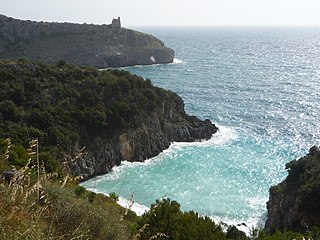 W
WCilento is an Italian geographical region of Campania in the central and southern part of the Province of Salerno and an important tourist area of southern Italy.
 W
WLake Iseo or Iseo lake, also known as Sebino, is the fourth largest lake in Lombardy, Italy, fed by the Oglio river.
 W
WMonte Marmagna is a mountain of the Apennine Mountains. It is located in Italy on the border between Tuscany and Emilia-Romagna.
 W
WMiramare Castle is a 19th-century castle direct on the Gulf of Trieste between Barcola and Grignano in Trieste, northeastern Italy. It was built from 1856 to 1860 for Austrian Archduke Ferdinand Maximilian and his wife, Charlotte of Belgium, later Emperor Maximilian I and Empress Carlota of Mexico, based on a design by Carl Junker.
 W
WMonte Circeo or Cape Circeo is a mountain remaining as a promontory that marks the southwestern limit of the former Pontine Marshes. Although a headland, it was not formed by coastal erosion – as headlands are usually formed – but is a remnant of the orogenic processes that created the Apennines. The entire coast of Lazio, on which the mountain and the marsh are located, was a chain of barrier islands that was formed on a horst and made part of the mainland by sedimentation of the intervening graben.
 W
WVal Camonica is one of the largest valleys of the central Alps, in eastern Lombardy, Italy. It extends about 90 kilometres (56 mi) from the Tonale Pass to Corna Trentapassi, in the commune of Pisogne near Lake Iseo. It has an area of about 1,335 km2 (515 sq mi) and 118,323 inhabitants.
 W
WVesuvius National Park is an Italian national park centered on the active volcano Vesuvius, southeast from Naples. The park was founded on June 5, 1995 and covers an area of around 135 square kilometers all located within the Province of Naples.
 W
WMonte Viso or Monviso, is the highest mountain of the Cottian Alps. It is located in Italy close to the French border. Monte Viso is well known for its pyramid-like shape and, because it is higher than all its neighbouring peaks by about 500 m, it can be seen from a great distance, including from the Piedmontese plateau, the Langhe, the Theodulpass in the Zermatt ski area and the summits of the Mont Blanc massif. On a very clear day it can be seen from the spires of Milan Cathedral. It has been suggested that Monte Viso could be one of the mountains which inspired the Paramount logo. In Italy it is also known as Il Re di Pietra because of its prominence within the western Italian Alps landscape. From 29 May 2013, it has become UNESCO's heritage as a cross-border biosphere reserve with France.